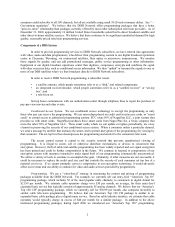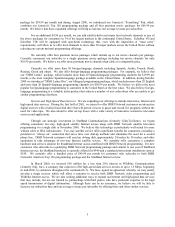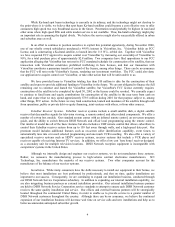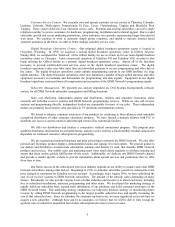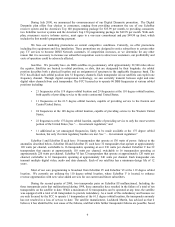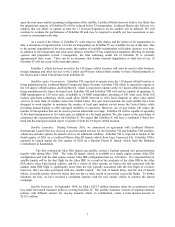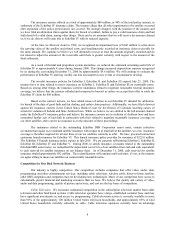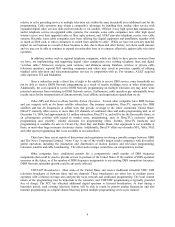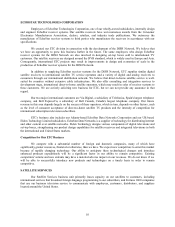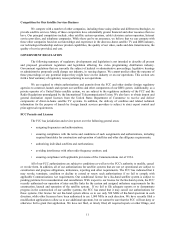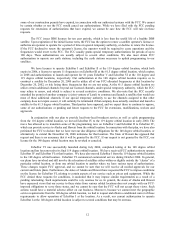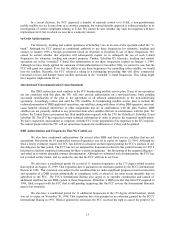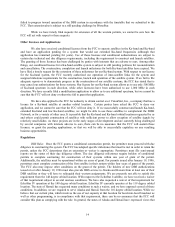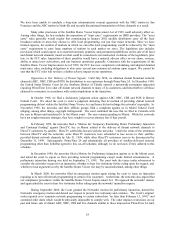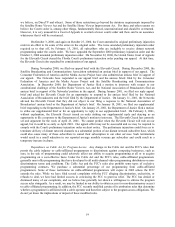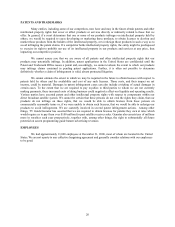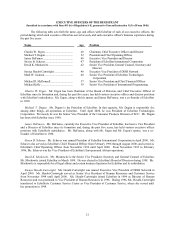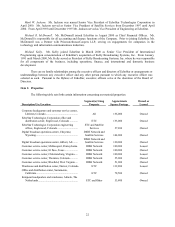Dish Network 2000 Annual Report Download - page 14
Download and view the complete annual report
Please find page 14 of the 2000 Dish Network annual report below. You can navigate through the pages in the report by either clicking on the pages listed below, or by using the keyword search tool below to find specific information within the annual report.12
some of our construction permits have expired, in connection with our authorized systems with the FCC. We cannot
be certain whether or not the FCC would cancel our authorizations. While we have filed with the FCC pending
requests for extensions of authorizations that have expired, we cannot be sure how the FCC will rule on these
requests.
The FCC issues DBS licenses for ten year periods, which is less than the useful life of a healthy DBS
satellite. Upon expiration of the initial license term, the FCC has the option to renew a satellite operator’s license or
authorize an operator to operate for a period of time on special temporary authority, or decline to renew the license.
If the FCC declined to renew the operator’s license, the operator would be required to cease operations and the
frequencies would revert to the FCC. The FCC usually grants special temporary authorizations for periods of up to
180 days. These authorizations are usually subject to several other conditions. We also must obtain FCC
authorization to operate our earth stations, including the earth stations necessary to uplink programming to our
satellites.
We have licenses to operate EchoStar I and EchoStar II at the 119 degree orbital location, which both
expire in 2006, a license to operate 11 frequencies on EchoStar III at the 61.5 degree orbital location, which expires
in 2008 and authorizations to launch and operate for 10 years EchoStar V and EchoStar VI at the 110 degree and
119 degree orbital locations, respectively. Our authorization at the 148 degree orbital location requires us to
construct a satellite by December 20, 2000 and to utilize all of our FCC-allocated frequencies at that location by
December 20, 2002, or risk losing those frequencies that we are not using. At the 61.5 degree orbital location we
utilize certain additional channels beyond our licensed channels, under special temporary authority, which the FCC
may refuse to renew, and which is subject to several restrictive conditions. We also note that the FCC recently
extended the permit of another company (a joint venture of Loral) to construct and launch a satellite that would use
most of these additional channels. If our special temporary authority to use the channels assigned to that other
company does not expire sooner, it will certainly be terminated if that company does actually construct and launch a
satellite to the 61.5 degree orbital location. Third parties have opposed, and we expect them to continue to oppose,
some of our authorizations or pending and future requests to the FCC for extensions, modifications, waivers and
approvals.
In conjunction with our plan to provide local-into-local broadcast service as well as cable programming
from the 110 degree orbital location, we moved EchoStar IV to the 119 degree orbital location in early 2000. The
move has allowed us to transition some of the programming now on EchoStar I and EchoStar II to EchoStar IV,
which can provide service to Alaska and Hawaii from the orbital location. In connection with that plan, we have also
petitioned the FCC to declare that we have met our due diligence obligations for the 148 degree orbital location, or
alternatively to extend the December 20, 2000 milestone for that location. The State of Hawaii has opposed that
request and there is no assurance that it will be granted by the FCC. If our request is not granted by the FCC, our
license for the 148 degree orbital location may be revoked or canceled.
EchoStar VI was successfully launched during July 2000, completed testing at the 148 degree orbital
location and has been moved to its final 119 degree orbital location. We have received FCC authorization to operate
EchoStar IV and EchoStar VI at that location. We have also moved EchoStar I from the 119 degree orbital location
to the 148 degree orbital location. EchoStar VI commenced commercial service during October 2000. In general,
our plans have involved and still involve the relocation of satellites either within or slightly outside the “cluster” of a
particular orbital location, or from one orbital location to another where we have various types of authorizations.
These changes require FCC approval, and we cannot be sure that we will receive all needed approvals for our
current and future plans. Furthermore, the states of Alaska and Hawaii have requested the FCC to impose conditions
on the license for EchoStar VI, relating to certain aspects of our service such as prices and equipment. While the
FCC denied these requests for conditions, it cautioned that it may impose similar requirements as a result of a
pending rulemaking. Such requirements could be very onerous for us. In general, the states of Alaska and Hawaii
have expressed views that our service to these states from various orbital locations does not comply with our FCC-
imposed obligations to serve those states, and we cannot be sure that the FCC will not accept these views. Such
actions would have a material adverse affect on our business. Moreover, because we cannot meet the geographic
service requirements from the 148 degree orbital location, we had to request and obtain a conditional waiver of these
requirements to allow operation of EchoStar I at the location. As a result, our current authorization to operate
EchoStar I at the 148 degree orbital location is subject to several conditions that may be onerous.


